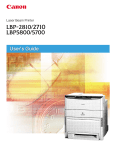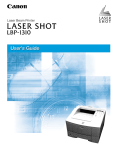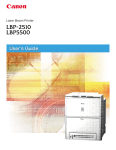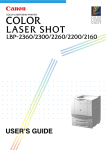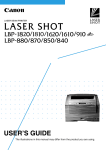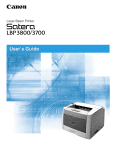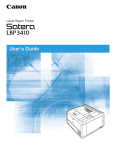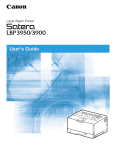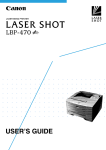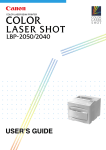Download Canon LBP-1710 User`s guide
Transcript
Laser Beam Printer User's Guide Table of Contents Table of Contents . . . . . . . . . . . . . . . . . . . . . . . . . . . . . . . . . . . . . . . . . . . 1 Turning the Printer On/Off . . . . . . . . . . . . . . . . . . . . . . . . . . . . . . . . . . . . 2 Turning On the Printer. . . . . . . . . . . . . . . . . . . . . . . . . . . . . . . . . . . . . . . . . . . .2 Turning Off the Printer. . . . . . . . . . . . . . . . . . . . . . . . . . . . . . . . . . . . . . . . . . . .3 About Online and Offline . . . . . . . . . . . . . . . . . . . . . . . . . . . . . . . . . . . . . 6 Online . . . . . . . . . . . . . . . . . . . . . . . . . . . . . . . . . . . . . . . . . . . . . . . . . . . . . . . .6 Offline . . . . . . . . . . . . . . . . . . . . . . . . . . . . . . . . . . . . . . . . . . . . . . . . . . . . . . . .7 Paper Requirements . . . . . . . . . . . . . . . . . . . . . . . . . . . . . . . . . . . . . . . . . 8 Printable Paper . . . . . . . . . . . . . . . . . . . . . . . . . . . . . . . . . . . . . . . . . . . . . . . . .8 Printable Areas . . . . . . . . . . . . . . . . . . . . . . . . . . . . . . . . . . . . . . . . . . . . . . . .13 Paper You Cannot Use . . . . . . . . . . . . . . . . . . . . . . . . . . . . . . . . . . . . . . . . . .14 Printing from the Paper Cassette . . . . . . . . . . . . . . . . . . . . . . . . . . . . . . 15 Loading Paper in the Paper Cassette . . . . . . . . . . . . . . . . . . . . . . . . . . . . . . .16 Printing from the Multi-Purpose Tray . . . . . . . . . . . . . . . . . . . . . . . . . . . 20 Loading Paper in the Multi-Purpose Tray . . . . . . . . . . . . . . . . . . . . . . . . . . . .21 Clearing Paper Jams . . . . . . . . . . . . . . . . . . . . . . . . . . . . . . . . . . . . . . . 30 Procedure for Clearing Paper Jams . . . . . . . . . . . . . . . . . . . . . . . . . . . . . . . .30 Replacing the Toner Cartridge . . . . . . . . . . . . . . . . . . . . . . . . . . . . . . . . 38 Canceling Printing . . . . . . . . . . . . . . . . . . . . . . . . . . . . . . . . . . . . . . . . . 43 Checking Operations . . . . . . . . . . . . . . . . . . . . . . . . . . . . . . . . . . . . . . . 45 Status Print . . . . . . . . . . . . . . . . . . . . . . . . . . . . . . . . . . . . . . . . . . . . . . . . . . .45 When a Message Is Displayed . . . . . . . . . . . . . . . . . . . . . . . . . . . . . . . . 47 When <nn-nn サービス コール > or <F9-nn チェック プリンタ > Is Displayed. . . . . . . . . . . . . . . . . . . . . . . . . . . . . . . . . . . . . . . . . . . . . . . . . . .47 Error Messages. . . . . . . . . . . . . . . . . . . . . . . . . . . . . . . . . . . . . . . . . . . . . . . .49 1 Turning the Printer On/Off Turning On the Printer When you turn the printer on, the printer performs a self-diagnostic test to check the status of the printer and any options installed, and then printing is enabled. IMPORTANT • Insert the paper cassette before turning the power on when the printer is being turned on for the first time after it has been installed. • A blank sheet of paper may be discharged when the power is turned on for the first time after the printer has been installed. This is normal, and is not a malfunction. 1 Press the power switch on the left side of the printer to the “I” position. When the power is turned on, the indicators and the LCD display on the control panel are turned on. Then, the printer performs a self-diagnostic test to check the status of the printer and any options installed. If no errors are found, the オンライン indicator, the 印刷可 indicator and the selected paper feed indicator light up, and the message <00 LIPS> appears on the display when the printer is ready to print. The information shown on the LCD display is as follows: Ready to print and no data is being processed for printing. 2 00 LIPS A4 Currently selected paper feed size. Turning Off the Printer The printer should be turned off as described in the following procedure. The procedure for turning off the power differs depending on whether or not the optional hard disk has been installed. (LBP-1710 only) IMPORTANT • If the printer has the optional hard disk installed, you should follow the designated procedure when turning off the power to protect the hard disk. (LBP-1710 only) (→ P. 4) • If the printer is connected to a network, make sure that the printer is not printing data from another personal computer before turning off the power. • If the power is turned off while the ジョブ indicator is on, the print data remaining in the • • • • • memory of the printer and the print data being spooled in the hard disk are erased (except for the print data stored in the box). Press [ 排出 ] while offline to output any important print data, or wait until printing is complete, before turning off the power. (→ P. 43) Do not turn off the power to the printer while it is printing. Do not turn off the power to the printer during the self-diagnostic test performed immediately after the power has been turned on. If the printer has a hard disk installed, make sure that the HD indicator (green) is not on. If the power is turned off while the HD indicator is on (the hard disk is reading or writing data), the hard disk may be damaged and become unusable. (LBP-1710 only) If the message that the NVRAM is initializing or writing data is displayed, make sure that the message has been canceled before turning off the power. If the message that the Flash Memory is initializing or deleting data is displayed, make sure that the message has been canceled before turning off the power. (LBP-1710 only) If the Printer is Not Using a Hard Disk If the hard disk has not been installed on the printer, turn off the power as described in the following procedure. 1 Make sure that the ジョブ indicator is off. 00 LIPS A4 off 3 2 Press the power switch on the left side of the printer to the “ ○ ” position. The power is turned off. If the Printer is Using a Hard Disk (LBP-1710 only) If the hard disk has been installed on the printer, turn off the power as described in the following procedure. IMPORTANT • If you attempt to shut down the printer when the paused job data or the secure job data still remains in the hard disk, the message < ジョブガ ノコッテイマス > appears. Once the shut down procedure has been selected, all the jobs are erased. However the job data in the box is left in the hard disk. To resume printing, press [ オンライン ], to go online. • Once the shut down procedure has been selected, you cannot cancel the operation. If you need to turn the printer on again, first turn off the power by following the instructions on the control panel and then turn the printer on again. 1 Make sure that the ジョブ indicator and HD indicator (green) are off. 00 LIPS A4 off 2 off Press [ オンライン ] to turn off the オンライン indicator. The printer gets ready for operation using the control panel. 4 3 Press [ 動作モード ]. The operation mode menu is displayed. ト゛ウサモート゛ LIPS → 4 Select <シャットダウン> by pressing [<] or [>], and then press [ ∨ ]. シャットタ゛ウン → The message <シャットダウン シマスカ?> is shown. シャットタ゛ウン シマスカ? 5 Check the message and press [ ∨ ]. シャットタ゛ウン シマスカ? The printer performs the shut down procedure and the message <デンゲンヲ オキリクダサイ> is shown when the printer is ready to be turned off. シ゛ッコウ チュウ テ゛ンケ゛ンヲ オキリクタ゛サイ 6 Press the power switch on the left side of the printer to the “○” position when the message <デンゲンヲ オキリクダサイ> is displayed. The power is turned off. 5 About Online and Offline When the printer can receive data from a personal computer and is able to print the data, this is called “online”, and when the printer cannot receive data, this is called “offline.” The printer should be offline when you perform operations from the menu on the control panel. Online The printer must be online in order to print data received from a personal computer. Make sure that the printer is online before you send a job to the printer. If the printer is not online, bring the printer online as described in the following procedure. The printer automatically comes online when it is turned on. 1 Press [ オンライン ] to turn on the オンライン indicator. The printer comes online and is ready for printing. IMPORTANT • If there is an error in the printer (when the メッセージ indicator (orange) is on or the digit part of the message is flashing), the printer will not come online. Eliminate the cause of the error before bringing the printer online. • The printer does not come online during operations such as selecting a menu function or a paper feed method, or setting the paper size. Complete the operation before bringing the printer online. • Do not open the cover of the printer or remove the paper cassette while printing. If the cover is opened or the paper cassette is removed, the printer will stop printing and may not be able to resume printing again. 6 ● Saving Power Consumption (Sleep Mode) After a specific time period has passed without any operation or without any data sent from the personal computer, the printer automatically switches to Sleep Mode. Sleep Mode is automatically canceled when any of the buttons on the control panel are pressed or an error occurs. Sleep Mode is also canceled if the printer has received data while it is online. Sleep Mode is also canceled when the error has been canceled while the printer is offline. NOTE • In the following cases the printer will not switch to Sleep Mode when the time-out has elapsed. - When the message <nn-nn サービスコール> (where nn is a 2-digit number) is displayed - During hard disk shutdown or initialization - When a utility function, such as Status Print, is being run Offline The printer must be offline when you use the menu on the control panel of the printer, to select the paper feeding method, or set the paper size. Check that the printer is offline before you press any keys on the control panel. If the printer is not offline, take it offline as described in the following procedure. 1 Press [ オンライン ] to turn off the オンライン indicator. The printer gets ready for operation using the control panel. IMPORTANT • If you try to print data from a personal computer while the printer is offline, a message, such as <プリンタの準備ができていません> or <プリンタが接続されていませ ん> is shown and the printer is not available for printing. • The printer automatically goes online after being left offline for more than five minutes. However, the printer does not come online when an error occurs (when the メッセージ indicator (orange) is on or the digit part of the message is flashing) or during operations such as selecting a menu function or the paper feeding method, or setting the paper size. 7 Paper Requirements Printable Paper You can use the following types of paper with this printer. ○ indicates that the paper type is supported, while × indicates that it is not supported. Paper Size Paper Source Multi-Purpose Tray Paper Cassette 250-Sheet Paper Feed Units (Option) B6*1 ○ × × A5 ○ ○ ○ A5R ○ × × B5 ○ ○ ○ B5R ○ × × A4 ○ ○ ○ A4R ○ ○ ○ B4*1 ○ ○ ○ A3* ○ ○ ○ Letter ○ ○ ○ Letter R ○ × × Executive ○ ○ ○ Executive R ○ × × Legal*1 ○ ○ ○ ○ ○ ○ ○ × × Type of Paper Plain Paper 64-90 g/m2 1 Ledger* 1 1 Custom Paper* Width: 76.2–297 mm Length: 98–431.8 mm 8 Heavy Paper (91–157 g/m2) Width: 100–297 mm Length: 98–431.8 mm ○ × × Transparencies A4 ○ × × Label sheets A4 × ○ ○ Postcards*1 ○ × × Stamped, self-addressed postcards*1 ○ × × Envelope Youkei No.2*2 ○ × × Envelope Youkei No.4*2 ○ × × *1 Load the paper in the portrait orientation. *2 Envelopes can be loaded only in the landscape orientation, with the flap open. Only non self-adhesive envelopes can be used with this printer. NOTE • Printing speed may decrease depending on settings such as paper orientation, size, type, and number of print copies. Postcard or Stamped, self-addressed postcard : About 5ppm Paper Capacity of Paper Sources Paper Source Multi-Purpose Tray Paper Cassette 250-Sheet Paper Feed Units (Option) About 100 sheets*3 About 250 sheets About 250 sheets Heavy Paper 128 g/m2 About 50 sheets × × Transparencies About 50 sheets × × × * 4 *4 Postcards About 40 sheets × × Stamped, self-addressed postcards About 40 sheets × × Envelopes About 10 sheets × × Type of Paper Plain Paper 64 g/m2 Label sheets *3 Only about 50 sheets can be loaded when using A3, A4R, B4, Ledger, Legal and Executive R size paper. *4 The maximum number of sheets of paper that can be loaded may vary depending on conditions, such as temperature and humidity. Never load label sheets higher than the limit mark. 9 Paper Capacity of the Paper Delivery Tray Paper Delivery Tray Type of Paper Face-down Delivery Tray Plain Paper 64 g/m2 About 250 sheets Heavy Paper 128 g/m2 About 150 sheets Transparencies About 100 sheets Label sheets 1 sheet Postcards About 50 sheets Stamped, self-addressed postcards About 50 sheets Envelopes About 10 sheets IMPORTANT • The printing speed may decrease depending on the type and the size of the paper used. Abbreviations of Paper Sizes The following abbreviations are used on the paper size selector for the paper cassette. Paper Size Ledger Paper size selector for the paper cassette 11X17 Legal LGL Letter LTR Executive EXEC Heavy (thick) Paper This printer can handle thick paper of 91-157 g/m2. Thick paper should be loaded in the multi-purpose tray. IMPORTANT • The size of thick paper (91-157 g/m2) that can be loaded in the multi-purpose tray is 100- 297 mm wide and 98-431.8 mm long. You can load up to about 50 sheets of 128 g/m2. • When printing with thick paper, always set [ 用紙タイプ ] in the printer driver’s [ 給紙 ] sheet (or [ デフォルト用紙タイプ ] in the set-up menu if you are using an OS which cannot run a Windows printer driver) to [ 厚紙 ]. 10 Transparency Film Transparencies may sometimes stick together. We recommend that you fan the transparencies, while holding them by the edges, before loading them in the multipurpose tray. IMPORTANT • Use only transparencies designed for this printer. If other types of transparencies are used, this may cause a paper feed failure or deterioration in print quality. • Be sure to load transparencies in the landscape orientation. • When printing on transparencies, always set [用紙タイプ] in the printer driver’s [給紙] sheet (or [ デフォルト用紙タイプ ] in the set-up menu if you are using an OS which cannot run a Windows printer driver) to [OHP]. Label Sheets Check which side of the label sheets is the face-up side and then load them face up into the paper cassette. IMPORTANT • Load label sheets in the paper cassette only. If they are loaded in the multi-purpose tray, this may cause hard to clear paper jams or a printer malfunction. • Do not use the following types of label sheets. If a sheet type that does not conform to specifications is used, this may cause hard to clear paper jams or a printer malfunction. - Sheets with labels that are likely to peel off, or sheets on which some of the labels have been used. - Coated sheets that can easily peel off from the backing sheet. - Label sheets with some adhesive surfaces exposed. • Be sure to load label sheets in the landscape orientation. • When printing on label sheets, always set [ 用紙タイプ ] in the printer driver’s [ 給紙 ] sheet (or [ デフォルト用紙タイプ ] in the set-up menu if you are using an OS which cannot run a Windows printer driver) to [ 普通紙 ]. • Remove each label sheet as soon as it is delivered into the delivery tray. Postcards Load postcards with the print side face down in the multi-purpose tray. For more details, see “Loading Postcards,” on P. 24. IMPORTANT • Do not use postcards other than official postcards. If other types of postcards are used, this may cause a deterioration in the print quality as well as paper jams. • You can use only stamped, self-addressed postcard without creases. • When the edges of postcards are curled, bend them back in the opposite direction to straighten them before loading them in the multi-purpose tray. • Do not use postcards for ink jet printers. • You cannot load postcards and stamped, self-addressed postcards in the landscape orientation. Be sure to load them in the portrait orientation. • When printing on stamped, self-addressed postcards, always set [ 往復はがき ] (or [ 往復はがき横 ] for Windows NT 4.0/2000) in the printer driver’s [ ページ設定 ] sheet, and then set [ 給紙方法 ] in the [ 給紙 ] sheet to [ 手差し ( トレイ )]. 11 Envelopes Open the flap and press the envelope with your hands to expel any air pockets and press down on the edges. Then load it face down in the multi-purpose tray. For more details, see “Loading Envelopes,” on P. 27. IMPORTANT • Never use the following types of envelopes. If envelopes that do not conform to specifications are used, this may cause hard to clear paper jam or a printer malfunction. - Envelopes with fasteners or snaps. - Envelopes with a window cut. - Self-adhesive envelopes - Envelopes with wrinkles or creases. - Envelopes with very irregular thickness at the folds or overlaps. - Envelopes with irregular shapes not rectangle. • Do not print on the back of envelopes. • Be sure to load envelopes in the landscape orientation. 12 Printable Areas The areas that can be printed on the paper are shown below. ■ Plain paper, thick paper, transparencies, label sheets 5 mm 5 mm 5 mm 5 mm ■ Postcards ■ Stamped, self-addressed postcards 100 mm 200 mm 5 mm 123-4567 東京都千代田区 ○○○ 148 mm 5 mm 5 mm 5 mm 5 mm 123-4567 東京都千代田区 ○○○ 148 mm 5 mm 5 mm 5 mm ■ Envelopes Adjust the printing location depending on the application being used. Youkei No.4 Youkei No.2 10 mm 105 mm 114 mm 10 mm 123-4567 ○東 ○京 ○都 千 代 田 区 162 mm 235 mm 10 mm 10 mm 10 mm 10 mm 10 mm 10 mm 13 Paper You Cannot Use To avoid problems such as paper jams and printer malfunctions, the following types of paper should never be used. IMPORTANT • Paper that tends to cause paper jams. - Paper that is too thick or too thin. Paper that is irregular shaped. Paper that is wet or holding moisture. Paper that is torn or damaged. Paper that is rough or extremely smooth. Paper that has holes for binding or perforations. Curled paper and paper with creases. Paper with a special coating on its surface (Coated paper for ink jet printers, etc.). Label sheets with the base easily peeled. Paper that has been used once by the printer, copy machine or other laser printers (the back of that paper is also improper). - Paper that has fins. - Paper that is wrinkled. - Paper that is folded at corners. • Paper that changes its quality at high temperature. - Paper that uses ink that melts, burns, evaporates or emits dangerous fumes at temperatures of 150 °C or higher. - Heat-sensitive paper. - Paper used for color printing with a processed surface. - Paper with a special coating on its surface. (Coated paper for ink jet printers, etc.) - Paper with adhesive on its surface. • Paper that causes failure or damage to the printer - Carbon paper. - Paper with staples, clips, ribbons or tapes. - Paper that has been used once by the printer, copy machine or other laser printers (the back of that paper is also improper). • Paper that is difficult for the toner to adhere to. - Paper with rough surfaces such as rough paper and Japanese paper. - Paper containing thick fibers. - Paper with special coating on its surface. (Coated paper for ink jet printers, etc.) 14 Printing from the Paper Cassette You can load up to 250 sheets of A5, B5, A4, A4R, B4, A3, Executive, Letter, Legal or Ledger-size plain paper (64 g/m2) into the paper cassette or optional paper feed unit. A4-size paper is normally loaded in the landscape orientation, however it can be loaded in the portrait orientation also. Label sheet is also acceptable. The paper should be loaded as shown below. Lengthways feed Sideways feed A4, Label sheet B5 A5 A3 B4 A4R Executive Letter Legal Ledger IMPORTANT • To avoid paper jams, note the following precautions. - Never remove the paper cassette while the printer is printing. This may cause paper jams or a printer malfunction. - Use only plain paper (64-90 g/m2) and label sheets. - Never use paper that has fins, or paper that is wrinkled or extremely curled. - Never stack paper in the paper cassette higher than the limit mark located inside the cassette. - For details about what kind of paper can be used, see “Paper Requirements,” on P. 8. - Refill the paper cassette with paper after the loaded paper has run out. Refilling the paper cassette with paper before paper has run out may lead to problems when feeding paper into the printer. - If the printer is using a hard disk, do not remove or insert the paper cassette while the HD indicator is turned on. • Load label sheets in the paper cassette only. If label sheets are loaded in the multipurpose tray, this may cause irrecoverable paper jams or a printer malfunction. • When printing on label sheets, always set [ 用紙タイプ ] in the printer driver’s [ 給紙 ] sheet (or [ デフォルト用紙タイプ ] in the set-up menu if you are using an OS which cannot run a Windows printer driver) to [ 普通紙 ]. • If A4-size paper is loaded in the paper cassettes in the landscape and portrait orientations respectively and [ 自動] is selected in the paper source settings, the landscape orientation is given priority. When you want to feed paper from the paper cassette loaded with paper in the portrait orientation, select the appropriate paper cassette in the printer driver (if you are using an OS that cannot run a printer driver, use the control panel) before printing. 15 Loading Paper in the Paper Cassette 1 Pull out the paper cassette until it stops. Remove it from the printer body by lifting the front of the cassette slightly. IMPORTANT • The paper cassette cannot be pulled straight out of the printer. If you use force to pull it out horizontally, the paper cassette may be damaged. 2 Adjust the extension cassette according to the paper size to be loaded. The lock release lever releases the cassette by pushing it inward and locks the cassette by pushing it outward. Shorten the extension cassette for landscape orientation. Extend the extension cassette for portrait orientation. Lock Release Lock Release Separation Pad IMPORTANT • Gently press the lock release levers using the inside of your fingers. 16 • Never touch the separation pad located at the front side of the cassette. It may lead to problems when feeding paper into the printer. 3 4 Press and hold the tab on the rear guide and slide it so that it aligns with the selected paper size. Slide the side guides so that they align with the selected paper size. The paper guides on both sides move together. 5 Fan the stack of paper, then tap it on a flat surface to properly align the edges. IMPORTANT • Fan the stack of paper well. Paper feed failure or paper jams may occur if the stack of paper is not fanned well. 17 6 Load the stack of paper so that it rests snugly against the rear guide and side guides. Limit Mark IMPORTANT • Do not load label sheets with plain paper. If you want to load label sheets when plain paper is loaded, remove all the plain paper, then load the label sheets. • Check which side of the label sheets is the face-up side and then load them face up into the paper cassette. • Be sure to load label sheets in the landscape orientation. • Make sure the paper stack is not above the limit mark. If the stack is higher than the limit mark, this may cause a paper feed failure. 7 Adjust the paper size selector according to the size of the paper loaded. The factory-preset is A4. Paper Size Selector IMPORTANT • Make sure that the paper size indicated by the selector is the same as the paper size loaded before inserting the paper cassette in the printer. Errors may occur if the paper size is incorrect. 18 8 Insert the paper cassette at a slight angle to insert it to the printer body. IMPORTANT • Do not let the paper cassette touch the floor, or other surfaces. If the paper cassette touches other surfaces, the position of the paper size selector may be moved. 9 When the extension cassette is extended, mount the cassette protecting cover on the back of the cassette. IMPORTANT • Do not put your hands, place objects or push strongly on the cassette protecting cover. Doing so, may damage the cover. 19 Printing from the Multi-Purpose Tray The size of paper that can be loaded in the multi-purpose tray is 76.2 mm-297 mm wide and 98 mm-431.8 mm long. The maximum number of sheets of paper that can be loaded in the tray varies depending on paper size and types. For more details, see “Paper Requirements,” on p. 8. You can load thick paper, transparencies, postcards, stamped, self-addressed postcards and special paper, which is useful when you want to use paper that is different type from the paper, in the paper cassette. When printing from the multi-purpose tray, you need to set the following items. ■ Load paper in the multi-purpose tray. (→ “Loading Paper in the Multi- Purpose Tray”, on P. 21) ■ Set the paper size. [ キュウシ ] group in the set-up menu [ トレイ ヨウシ サイズ ] = the paper size to be loaded ■ Set the paper type. If printing from an OS which cannot run a printer driver, set the following item. [ キュウシ ] group in the set-up menu [ デフォルト ヨウシ タイプ ] = the paper type normally used ■ Set the printer driver. When printing from the printer driver, set the following items. The items to be set may vary depending on the OS. The following are items to be set in the printer driver for Windows 98. [ページ設定]sheet [出力用紙サイズ]= the paper size to be set [給紙]sheet [用紙タイプ]= the paper type to be set [給紙方法]=[手差し(トレイ)] IMPORTANT • The size of thick paper (91-157 g/m2) that can be loaded in the multi-purpose tray is 100297 mm wide and 98-431.8 mm long. You can load up to about 50 sheets of 128 g/m2. • When printing with thick paper, always set [ 用紙タイプ ] in the printer driver’s [ 給紙 ] sheet (or [ デフォルト用紙タイプ ] in the set-up menu if you are using an OS which cannot run a Windows printer driver) to [ 厚紙 ]. • Never load label sheets in the multi-purpose tray. If they are loaded in the tray, this may cause hard to clear paper jams or a printer malfunction. Be sure to load label sheets in the paper cassette. (→“Printing from the Paper Cassette,” on P. 15) 20 Loading Paper in the Multi-Purpose Tray Loading Paper (other than postcards and envelopes) To load plain paper, thick paper, or transparencies in the multi-purpose tray, follow the procedure described below. IMPORTANT • Data cannot be printed in the 5 mm wide border of the paper. • Be sure to load transparencies in the landscape orientation. • Use only transparencies designed for this printer. If other types of transparencies are used, this may cause a paper feed failure or deterioration in print quality. • Never load label sheets in the multi-purpose tray. If they are loaded in the tray, this may cause hard to clear paper jams or a printer malfunction. Be sure to load label sheets in the paper cassette. 1 Grasp the tabs on both sides of the multi-purpose tray and gently pull it open. IMPORTANT • Support the tray with both hands and gently pull it open. When loading long size paper, such as B4 or A3, open the extension tray. IMPORTANT • To avoid damaging the multi-purpose tray and extension tray, do not place anything other than paper in them. In addition, avoid pressing or applying excessive force on the tray as this may damage it. • To avoid damaging the multi-purpose tray, do not close the multi-purpose tray with the extension tray left opened. 21 ● Closing the multi-purpose tray To close the multi-purpose tray, reverse the procedure for opening the tray. When you are not using the tray, keep it closed. 2 Fan the stack of paper, then tap it on a flat surface to properly align the edges. Align the edges of the stack of paper on a flat surface. IMPORTANT • When fanning or aligning transparencies, always hold the edges, where possible, to avoid touching the print side. • Be sure to load a stack of transparencies after thoroughly fanning them. Otherwise, they can be fed overlapped, causing paper jams. • Take care not to mark/stain the print side of transparencies with fingerprints, dust or oil. This may cause poor printing. • If the leading edge of the paper is bent or curled, straighten out the paper before loading it into the tray. 3 22 Set the paper guide width slightly larger than the paper width. 4 Insert the paper stack as far as it will go into the printer, with the print side facing down and the top of the paper facing toward the printer. Press the paper stack so it is below the limit guide. Limit Guide IMPORTANT • There must be some space left between the stack of paper and limit guide. Do not use force when loading the paper as this may cause a paper feed failure. • The number of pages that can be fed from the multi-purpose tray varies depending on the paper size and type. (→ “Paper Requirements,” on P. 8) • Make sure that the paper in the paper stack is aligned. • Be sure to load transparencies in the landscape orientation. NOTE • When paper such as A4- or Letter-size paper is loaded in the landscape orientation, the left side of the paper will be the top end of image as viewed from the front of the printer. • When paper such as B4- or A3-size paper is loaded in the portrait orientation, the far side of the paper will be the top end of image. 5 Slide the paper guides so that they closely fit the right and left edges of the paper. 23 IMPORTANT • Be sure to set the paper guides to the paper width. Misfeeds or paper jams may occur if the paper guides are too loose or too tight. Loading Postcards You can load up to 40 official postcards (100 mm x 148 mm) and stamped, selfaddressed postcards (200 mm x 148 mm) without creases in the portrait orientation. To load postcards in the multi-purpose tray, follow the procedure described below. IMPORTANT • Do not use postcards other than official postcards. If other types of postcards are used, this may cause a deterioration in the print quality and paper jams. • Data cannot be printed in the 5 mm wide border of the postcard. • You cannot load postcards and stamped, self-addressed postcards in the landscape orientation. Be sure to load them in the portrait orientation. • Do not use postcards for ink jet printers. 1 Grasp the tabs on both sides of the multi-purpose tray and gently pull it open. When loading stamped, self-addressed postcards, open the extension tray. IMPORTANT • Support the tray with both hands and gently pull it open. 24 2 Fan the stack of postcards, then tap it on a flat surface to properly align the edges. Align the edges of the stack of postcards on a flat surface. IMPORTANT • If the postcards are warped, correct the warp so that it does not exceed 2 mm in an upward direction. Then fan the stack of postcards to make sure that none of the postcards are stuck together before loading the stack into the multi-purpose tray. No more than 2 mm 3 4 Set the paper guide width slightly larger than the postcard width. Load the stack of postcards or stamped, self-addressed postcards in the multi-purpose tray. Press the stack so that it is below the limit guide. You can load up to about 40 postcards or stamped, self-addressed postcards in the multi-purpose tray. When loading postcards, insert the stack as far as it will go into the printer, with the print side of the postcards facing down and the top of the postcards going into the printer first. Limit Guide 25 To load a stamped, self-addressed postcard in the multi-purpose tray, gently insert the postcard as far as it will go into the printer, with the print side facing down, and the top edge on the right. IMPORTANT • There must be some space left between the stack of postcards and limit guide. Do not use force when loading the stack of postcards as this may cause a paper feed failure. • Never use stamped, self-addressed postcards with creases. • Be sure to load stamped, self-addressed postcards in the portrait orientation. You cannot load them in the landscape orientation. Furthermore, when you print on a stamped, self-addressed postcard, make sure that the application page setup and orientation settings match the way the postcard is loaded in the multi-purpose tray. (Example: For Windows NT 4.0/Windows 2000, select [ 往復はがき横 ].) 5 Slide the paper guides so that they closely fit the right and left edges of the postcard. IMPORTANT • Be sure to set the paper guides to the postcard width. Misfeeds or paper jams may occur if the paper guides are too loose or too tight. 26 Loading Envelopes The multi-purpose tray can hold Youkei No.4, and Youkei No.2 envelopes. To load envelopes in the multi-purpose tray, follow the procedure described below. IMPORTANT • You can load envelopes of the sizes shown below: Youkei No.4 (105 mm×235 mm) Youkei No.2 (114 mm×162 mm) • Do not use self-adhesive envelopes. This may cause a deterioration in the print quality or printer malfunction. • Data cannot be printed in the 10 mm wide border of the envelope. • Be sure to load envelopes in the landscape orientation. 1 Grasp the tabs on both sides of the multi-purpose tray and gently pull it open. If necessary, open the extension tray. IMPORTANT • Support the multi-purpose tray with both hands and gently pull it open. 2 Place the envelopes on a flat surface, with the flap open. Press down the corners to crease and flatten the envelopes. Align the edges of the stack of envelopes on a flat surface. 27 3 4 5 Fan the envelopes, holding them at both edges. Set the paper guide width slightly larger than the envelope width. Insert the envelope stack into the printer as far as it will go, with the print side facing down and the flap open. Press the envelope stack so that it is below the limit guide. The multi-purpose tray can hold about ten envelopes. Limit Guide IMPORTANT • There must be some space left between the stack of envelopes and limit guide. Do not use force to load the stack of envelopes as this may cause a paper feed failure. • You cannot print on the back (adhesive surface) of the envelope. • Load the envelope with the flap open and facing away from the printer as illustrated below. 28 6 Slide the paper guides so that they closely fit the right and left edges of the envelopes IMPORTANT • Make sure the paper guides are set to the size of the envelopes. A paper feed failure or paper jams may occur if they are too loose or too tight. 29 Clearing Paper Jams When a paper jam occurs during printing, a warning beep will sound and the error message < 13 ヨウシガツマリマシタ> will appear on the display. When a paper jam occurs, follow the procedure below to remove the jammed paper from the printer and then resume printing. If the message remains after removing the jammed paper according to the prescribed procedure, torn pieces of the jammed paper may still remain in the printer. In this case, re-check various sections of the printer and remove all pieces of the jammed paper from inside the printer. Procedure for Clearing Paper Jams If a paper jam occurs, check the message on the display first, reset the pressure releasing lever, and then remove the jammed paper. IMPORTANT • The fixing unit may be hot during operation. Do not touch the fixing unit and its peripherals as this may cause personal injury or burns. 30 IMPORTANT • Never touch the high-voltage contact points inside the front cover. This could damage the printer. High-Voltage Terminals • Remove the jammed paper while the power to the printer still on. If you turn the power off, the print data will be erased. • When you have opened the front cover, take care not to touch the transfer roller and discharger inside the front cover. • Do not touch the drum when removing paper. • If you attempt to remove the jammed paper forcibly, the paper may be torn or parts inside the printer may be damaged. Pull out the jammed paper in the correct direction according to the location at which the paper is jammed. • If the jammed paper has torn, find the scraps pieces of the paper remaining inside the printer and remove them. 1 Check all the messages appearing on the display. The error messages and the locations are shown one by one on the display. Check all of them. The messages will disappear when you open the front cover. It is recommended that you note down the messages. 13 ヨウシカ゛ツマリマシタ マエ カハ゛ー エリア The message indicates the location of the paper jam. The following types of messages are shown on the display. When two or more messages appear on the display, note down all of them and check them one by one, in sequence. Display message Location of a paper jam <マエ カバー エリア> Front cover area 1 <ハイシ エリア> Paper delivery area 2 <キュウシ エリア> Paper feed area 3 Checking sequence 31 2 Grasp the tabs on both sides of the multi-purpose tray and gently pull it open. If the paper was fed from the multi-purpose tray, proceed to the next step. IMPORTANT • Support the multi-purpose tray with both hands and gently pull it open. 3 4 Remove the paper jammed in the multi-purpose tray. Pull the right and left release levers inside the multi-purpose tray area towards you, and then pull the front cover forward until it stops. If you have trouble removing the front cover, lift it slightly. This will enable you to remove the front cover. IMPORTANT • Place the front cover in a safe place where it will not be damaged. 32 5 6 Press down the right and left green pressure release levers to release the pressure applied by the fixing unit. When the message <マエ カバー エリア> appears on the display, gently pull out the paper jammed in the front cover using both hands. 33 7 When the message <ハイシ エリア> is displayed, pull out the jammed paper with both hands as illustrated below. If you can see the jammed paper inside the front cover, pull it out with both hands. If you cannot see the jammed paper inside the front cover, pull it out with both hands from the paper delivery tray. NOTE • Open the paper delivery cover to make sure there are no scraps of paper left inside the printer after you have removed the jammed paper. Paper Delivery Cover 34 8 When the message <キュウシ エリア> appears on the display, pull out the paper cassette until it stops, and then remove it from the printer body by lifting the front of the cassette slightly. When an optional paper feed unit is attached to your printer, remove all the paper cassettes starting from the top cassette. 1 2 3 4 IMPORTANT • Remove the paper cassettes starting from the top cassette. If you remove them starting from the bottom cassette, the jammed paper may tear, leading to more paper jams. • Paper cassettes cannot be pulled out horizontally. If you try to force a paper cassette out horizontally, it may be damaged. 35 9 10 36 Pull out the paper jammed in the front cover using both hands. Load the paper in the paper cassette and re-install the paper cassette in the printer. 11 12 Raise the right and left pressure release levers to lock them in place. Close the front cover and raise the right and left release levers to lock them in place. IMPORTANT • Do not leave the front cover open for a long time after installing a toner cartridge. 13 Close the multi-purpose tray. 37 Replacing the Toner Cartridge To replace the toner cartridge, follow the procedure described below. WARNING • To avoid a fire or personal injury, never attempt to incinerate a used toner cartridge. Toner residue inside the cartridge is flammable and if it is scattered near an open flame, this may result in a fire or personal injury. CAUTION • If you get loose toner powder on your hands or clothing, wash it off with cold water immediately. Using warm water may fix the toner to your hands or clothing, making it difficult to remove. 1 When the printer has stopped printing, grasp the tabs on both sides of the multi-purpose tray and gently pull it open. IMPORTANT • Support the tray with both hands and gently pull it open. 2 Pull the right and left release levers inside the multi-purpose tray area towards you, then pull the front cover forward. IMPORTANT • Never touch the transfer roller or the discharger inside the front cover. This could reduce the print quality. 38 3 4 Remove the toner cartridge from the printer by grasping it by the right and left handles and pulling it out horizontally. Remove the new toner cartridge from its protective bag. IMPORTANT • We recommend that you use Canon toner cartridges for optimum printing results. • Handle the toner cartridge so that the side with arrow always faces up, as illustrated below. Do not stand the cartridge on end, and do not turn it upside down. • Save the protective bag. You may need it later when removing the toner cartridge for maintenance of the printer. 39 5 Hold the toner cartridge as illustrated below and gently rock it 5 or 6 times in a horizontal direction 1, then another 5 or 6 times in a vertical direction 2 to evenly distribute the toner. 1 2 1 IMPORTANT • If toner is not evenly distributed inside the cartridge, this may cause a deterioration in the print quality. 6 Place the cartridge on a sturdy surface, then pull the sealing tape straight out of the cartridge while holding the cartridge. IMPORTANT • Remove the sealing tape completely from the cartridge. Otherwise, this may cause a deterioration in the print quality. • Do not pull the tape diagonally upwards or downwards as the tape may snap off. If you do not remove the sealing tape completely, you may not be able to use the toner cartridge. • Do not stop pulling the sealing tape part way. If you stop pulling it, loose toner will scatter around causing a reduction in print quality. • Dispose of the sealing tape properly. 7 40 Remove the tapes attaching the protective cover to the toner cartridge. Then remove the protective cover by pressing the two levers on the top edge of the cover. IMPORTANT • Do not re-attach the protective cover once it has been removed, as this may damage the drum. • Do not touch the drum of the toner cartridge. Drum • Do not scratch the drum of the toner cartridge. 8 9 Hold the toner cartridge with both hands, align right and left handles of the cartridge with the guides inside the printer and insert the cartridge horizontally into the printer as illustrated below. Push the handles of the toner cartridge to insert it into the printer securely. 41 10 Close the front cover and push the right and left release levers back into position to lock the cover in place. IMPORTANT • If the toner cartridge is not correctly installed, the front cover will not close completely. Do not try to force the cover shut, as this could damage it. If you cannot close the front cover completely, open it and check the installation of the toner cartridge. • Do not leave the front cover open for a long time after installing a toner cartridge. 11 Close the multi-purpose tray. ● Recycling Toner Cartridges Canon supports the collection of used toner cartridges for recycling. Toner cartridge recycling cannot succeed without your help. We would like to encourage you to support the Canon Cartridge Recycling Program and bring your used cartridge to the CANON distributor from which you have purchased the cartridge or to your nearest CANON dealer. 42 Canceling Printing To cancel printing currently being processed, follow the procedure described below to perform job cancel. Job cancel lets you cancel a job while data is being received or processed. It does not affect the print data for the next job or any other interface jobs for which data processing has not begun. IMPORTANT • Perform job cancel offline when data is being processed (when the ジョブ indicator is on or flashing). If you press [ ジョブキャンセル ] when the ジョブ indicator is off, this activates the [ ユーティリティ ] function. • Data that has already been processed and is currently being printed (when paper feeding has begun) cannot be canceled. In this case, be careful because performing job cancel may cancel the print data for the next job. • If print data sent from a printer driver not compatible with this printer is mixed with other data, multiple print jobs may be canceled. NOTE • When job cancel is performed, the message <03 ジョブ キャンセル > is displayed. However the print job data may not be canceled. You cannot cancel secure job data before entering a password, or job data to be stored in the box. Follow the procedure described below to perform job cancel. Only perform job cancel when the ジョブ indicator is on or flashing (when the print data for the job you want to cancel is being received or processed). 1 Press [ オンライン ] to turn off the オンライン indicator. The printer gets ready for operation using the control panel. NOTE • The display changes depending on the printer status. During job processing, the operation mode, a user name or printer status is shown alternately. 43 2 Press [ ジョブキャンセル ]. The message < 03 ジョブ キャンセル> appears on the display and the print data being processed is canceled. 03 シ゛ョフ゛ キャンセル 00 シ゛ョフ゛ スキッフ゜ 00 LIPS A 4 When processing takes time, such as when receiving data, the message on the display changes to < 00 ジョブ スキップ> . When the message <00 LIPS > appears on the display, job cancel is complete. NOTE • When the message <00 ジョブ スキップ> appears on the display, you can press [リセット] to perform a soft reset or hard reset. If you perform a reset, any print data being received or any other interface print data will be lost. In this case, perform printing again. • When the message < 03 ジョブ キャンセル> appears on the display, you cannot perform a soft reset or hard reset. Wait until job cancel is complete or the message < 00 ジョブ スキップ> appears on the display. 44 Checking Operations You can use the status print to check the configuration of the printer. Use this function whenever necessary, such as after preparing and connecting the printer or whenever you want to check its operating status. Status Print Currently available printer functions and a list of setting values are printed in a status print. To perform a status print, follow the procedure described below. 1 Press [ オンライン ] to turn off the オンライン indicator. The printer gets ready for operation using the control panel. 2 Press [ ユーティリティ ]. The message <ステータス プリント> appears on the display. ユーティリティ ステータス フ゜リント → 3 Press [ ∨ ]. ステータス フ゜リント → The message < 01 ステータス プリント> appears on the display and the status print begins. 01 ステータス フ゜リント → 45 Status print contents A status print is printed as shown below. It allows you to check functions that can be currently used, provides a list of setting values in the printer function menu, and versions of software and hardware installed in the printers as well as the page count. 46 When a Message Is Displayed When <nn-nn サービス コール > or <F9-nn チェック プリンタ > Is Displayed If a problem has occurred internally in the printer, or if a problem has occurred while print data was being processed, an error message (error code and message) is displayed. An error code is a four-digit number as shown in the illustration below. Error code Message 5F-50 サービス コール Error code Message When these types of messages are displayed, make a note of the four-digit number on the display, and then take the following actions. F9-nn チェックプリンタ 1 Turn the printer’s power to off, wait for a while, and then turn the power back to on. If the message is not displayed again, you can use the printer as it is. 47 2 If the message is displayed again, turn the printer’s power to off. Disconnect the power plug and remove the earth cable from the earth terminal. Then contact the place where you purchased the printer. When you contact the place of purchase, describe the problem and quote the four-digit number. NOTE • When the message <5F-nn サービスコール > is displayed, condensation may have formed inside the printer. Let the printer stand for two hours or more so that it adjusts to the surrounding temperature and humidity. If you print while there is condensation inside the printer, the paper may not feed properly causing paper jams, and the print quality may also be poor. 48 Error Messages If the printer is unable to print for some reason, an alarm sounds, the error indicator lights up and an error message appears on the display. Furthermore, a warning message is displayed when you are required to take some sort of action, even though there is no problem with the print job. When these types of messages are displayed, take the following actions in response. IMPORTANT • When multiple warning messages occur at the same time, the messages are displayed alternately. • When an error message occurs at the same time as a warning message, the warning message is not displayed. • When [ ケイコクヒョウジ ] in the set-up menu is set to [ シナイ ], a message with <Warning message> symbol is not displayed. • When a message with the <Error skip> symbol is displayed, press [オンライン] to bypass the error and continue printing. However if you do this, print data may be lost or the data may not be printed correctly. If you want to cancel the procedure, perform a soft reset to remove the cause of the problem and then press [ オンライン ] to print the data again. Furthermore, messages marked with this symbol can be automatically skipped by setting [ 自動エラースキップ ] to [ ツカウ ]. Cause and Remedy Message Cause: 11 XXX ヨウシガアリマセン (where XXX is the paper size abbreviation) The paper size specified in an application software has not been loaded in the paper cassette or paper tray. (When the paper feed mode is set to [ 自動 ], this applies to all paper cassettes and the paper tray. When the paper feed mode is fixed, this applies to a paper cassette or the paper tray.) Remedy: Add paper to the paper source or, if there is no paper in the paper source, load paper into it. 12 カバーガ アイテイマス Cause: The front cover is open. Remedy: Close the front cover firmly. 13 ヨウシガ ツマリマシタ Cause: Paper has jammed inside the printer. Remedy: Clear the paper jam. Cause: 14 EP カートリッジ ナシ The toner cartridge has not been installed. Remedy: Install the toner cartridge. 49 Cause and Remedy Message Cause: 16 トナー チェック <Warning message> The amount of remaining toner is low. Remedy: Remove the toner cartridge and gently rock it 5 or 6 times in the vertical and horizontal directions. Then re-install the cartridge in the printer. If the message is still displayed after this, or white streaks appear on the printout, replace the toner cartridge with a new one. 16 トナー コウカン <Error skip> Cause: The cartridge is out of toner. Remedy: Replace the toner cartridge with a new one. 17 カセット n ヨウシ ナシ (n is the cassette number.) <Warning message> 19 ヨウシガノコッテイマス <Warning message> Cause: Paper in the cassette of the number indicated on the display has run out. Remedy: Load paper into the cassette of the number indicated on the display. Cause: There is still paper inside the printer. Remedy: Any paper still in the printer will be output automatically. Cause: 40 ツウシン エラー <Error skip> An error occurred when data was being transferred between a PC and the printer. Remedy: Check the interface cable connection and print the data again. Cause: 41 プリント チェック <Error skip> 50 The sizes of the paper loaded in the paper cassette and paper tray are different to the paper size settings for the paper cassette and paper tray. Remedy: When paper is being fed from the paper cassette, make sure that the size of the paper loaded in the paper cassette is the same as the paper size settings on the paper size selector. Also when paper is being fed from the paper tray, make sure that the size of the paper loaded in the paper tray is the same as the paper size settings for the paper tray before you press [ オンライン ]. Cause and Remedy Message Cause: PC XXX ヨウシ ニ コウカン (where XXX is the paper size abbreviation) <Error skip> Either the size of the paper loaded in the paper source is different to the paper size setting in the application software, or a paper source in which a different size of paper is loaded has been selected. Remedy: Replace the paper in the selected paper source with paper of the size specified by the application software (or scaling setting). 51




















































